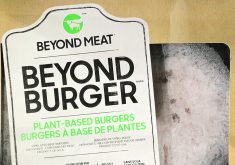Many people today are looking to cut their consumption of pork, beef, chicken and other animal proteins. And many might believe that proteins from plants are healthier and more environmentally friendly.
But if a plant-based protein doesn’t deliver on taste or value, the better for you and better for the planet slogans will not work, said a food retail expert from Nova Scotia.
“(If) a Beyond Meat burger patty costs the same or even more, and I’m a consumer who is animal or plant, then I’m going to make a price decision,” said Peter Chapman, who worked for Loblaw’s for nearly 20 years before starting a consultancy business.
Related story: Study predicts growth in plant-based meat sales
In 2020 and into 2021, sales of plant-based proteins peaked. North Americans eagerly tried a new veggie burger at their favourite fast-food restaurant or bought plant-based “chicken” nuggets at grocery stores.
The initial wave of popularity didn’t last.
“(United States) sales of meat alternatives have fallen steadily since 2021 and more sharply over the last year,” says a report released in August from CoBank, which serves rural America and agri-businesses.
“Volume of sales dropped 20.9 percent for the 52-week period ending July 2, 2023, according to consumer behavior research firm Circana.”
Like Chapman, the CoBank report said there are flexitarians who want to eat plant proteins a few days per week. But many consumers were disappointed by the products introduced in 2019 and 2020.
“Fewer than half of Americans who tried the products at the time, repeated their purchase, per data from consumer research firm Mintel,” the CoBank report stated.
One reason for the boom in sales, during 2020, was that plant-based meats were everywhere.
Large players, like Beyond Meat, rushed into the market and bought coolers of space at major retailers. The volume of product may have artificially boosted sales.
“We saw products getting shelf space with upfront investments and the belief from both retailers and suppliers that they would sell,” Chapman wrote in a FCC blog.
“We probably saw over-merchandizing of these products, relative to the size of the demand.”
Chapman said sustainability was a larger consideration among consumers three to four years ago.
When inflation pushed food prices seven to 10 percent higher, Canadians and Americans set other priorities at the grocery store. Trying to save the planet by eating a plant-based sausage dropped down the list. Price became the number one priority.

It is possible for plant-based proteins to make a comeback, but food processors and retailers need a different approach, said Chapman, who runs a consultancy called SKUFood, which serves producers and processors in the food business.
Chapman said it could be a mistake to brand a plant-based protein as a “burger” or a “sausage”.
“So many of the articles I read say it’s a ‘tuna alternative’, or it’s a ‘chicken nugget’ alternative,” he said. “When you say ‘tuna alternative’, you’ve set an expectation with the consumer. And it’s very difficult to meet that or exceed it.”
Instead, plant protein manufacturers should focus on a great-tasting product, not something that looks and tastes like a chicken nugget.
If that happens, an uptick in sales is possible, but a sales boom seems unlikely, he said.
“We do know there is a segment there, looking to reduce their (consumption) of animal protein,” he said.
“I think it’s going to take some time…. We’ll see probably a slight rebound. I don’t think we’ll get back to when we were over-merchandizing.”


















